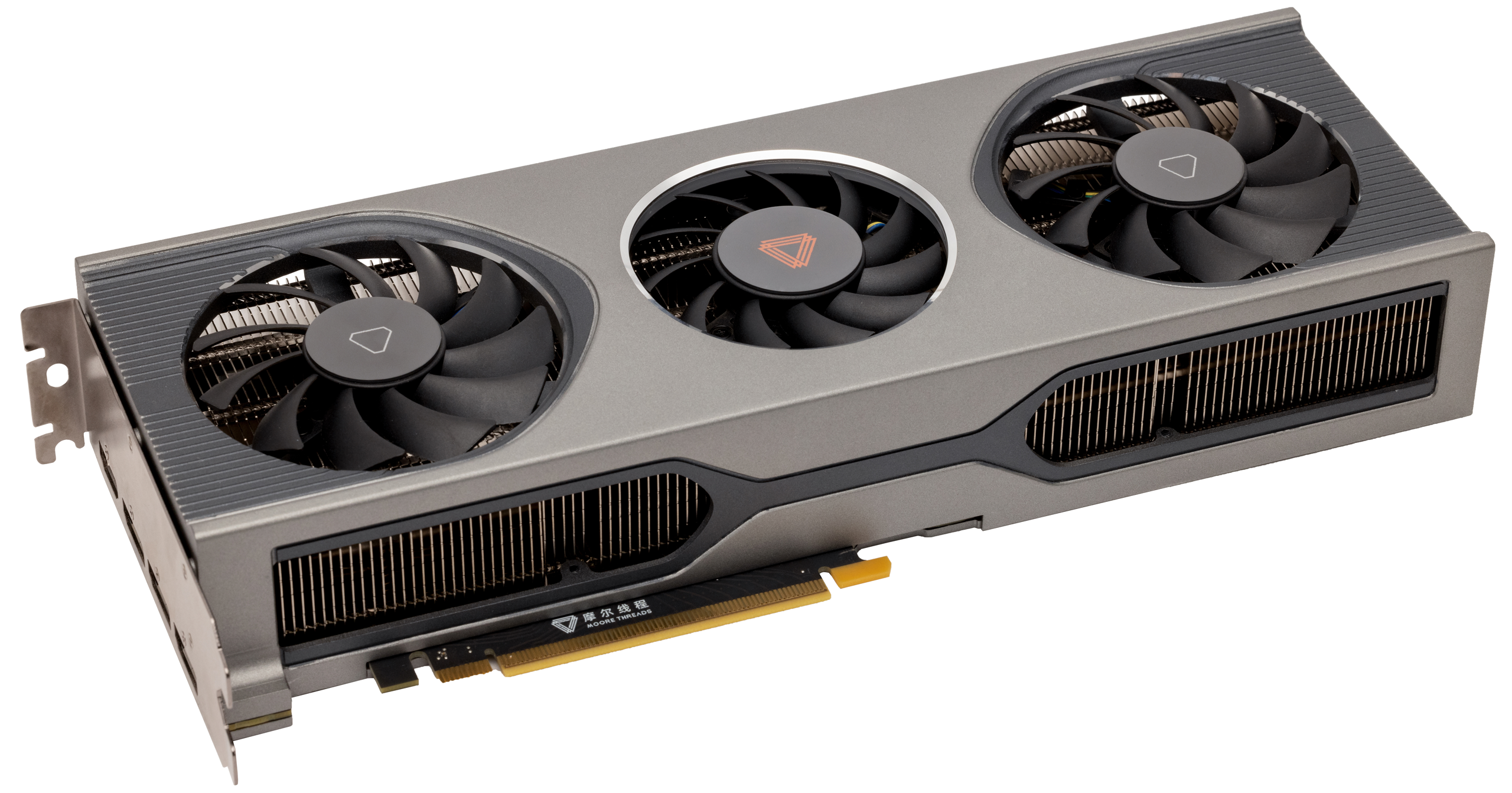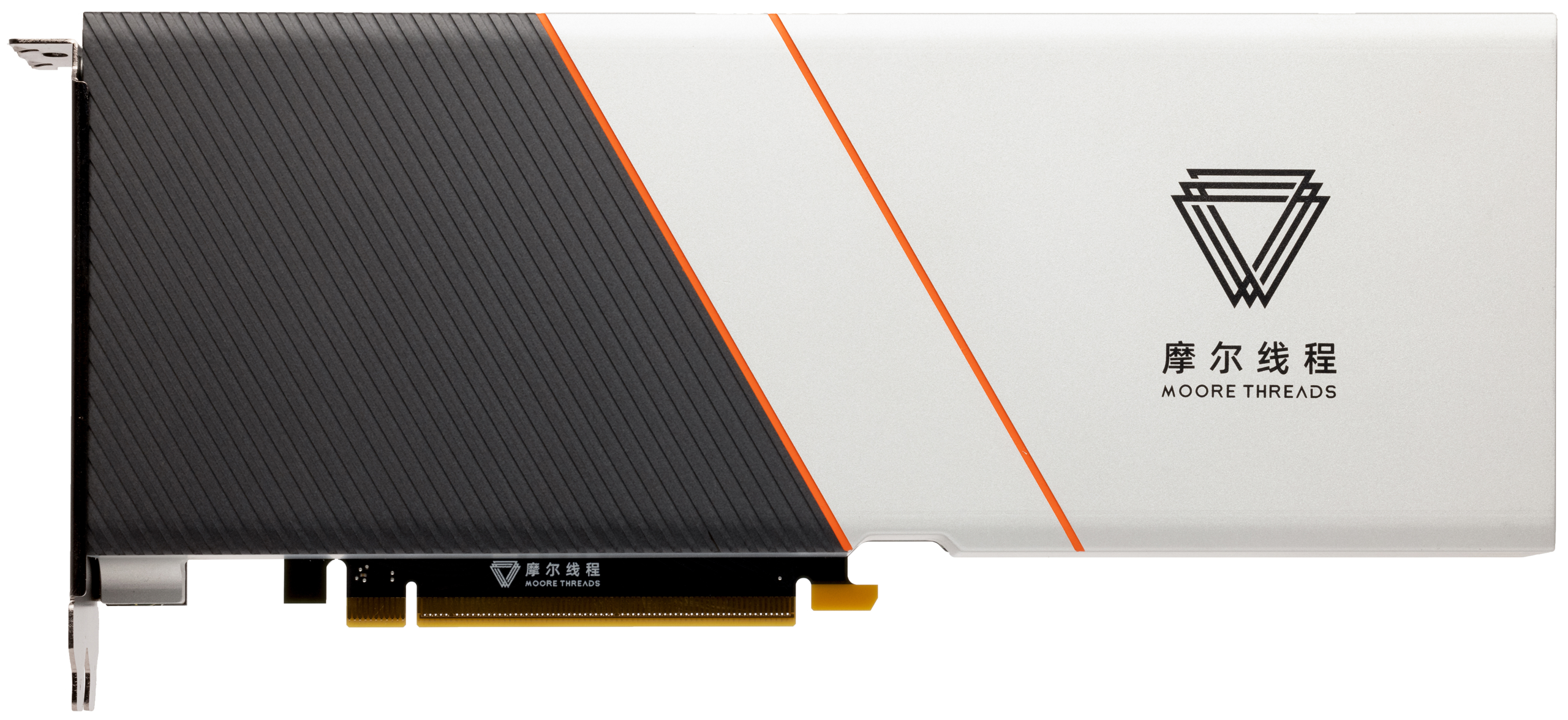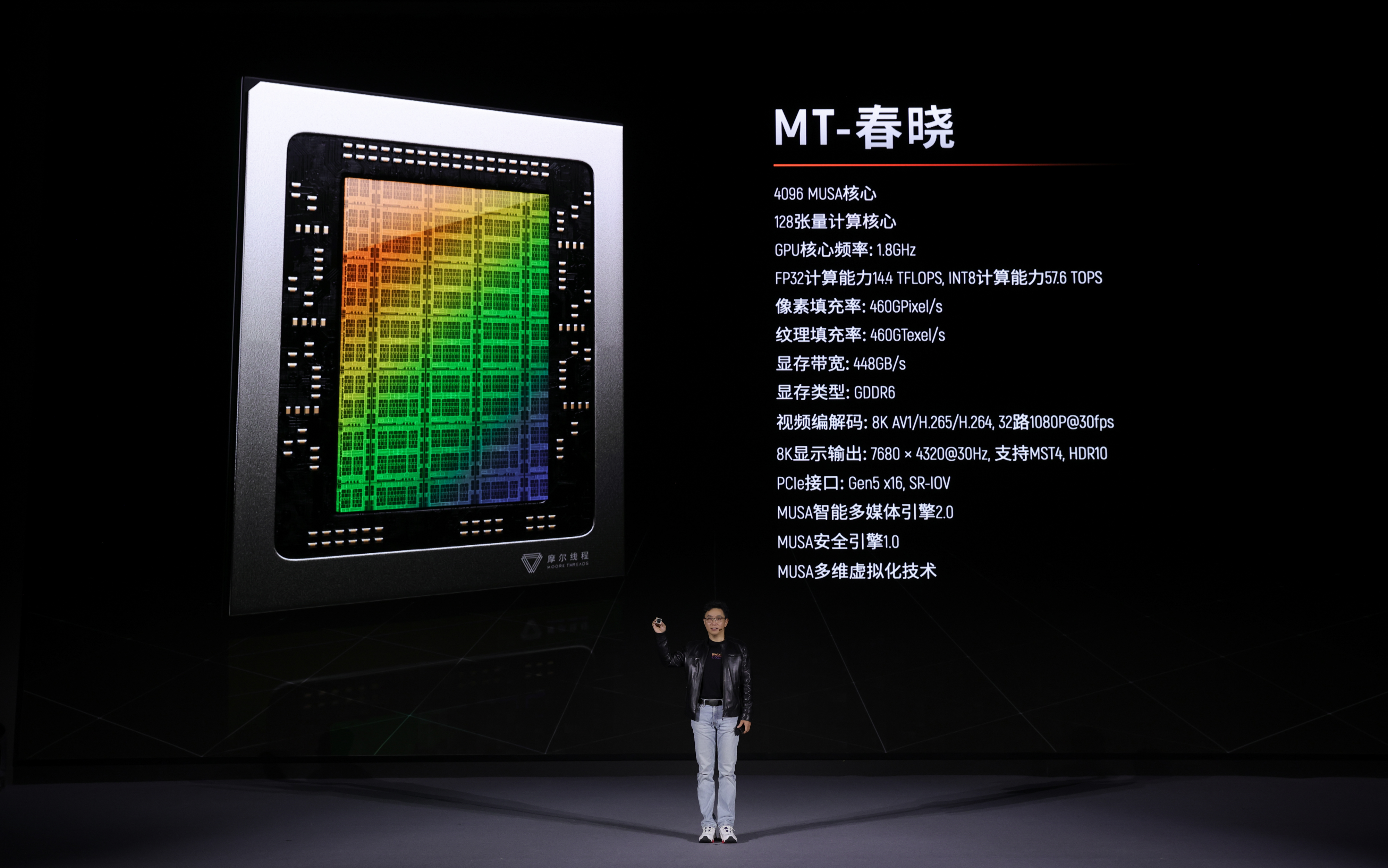Chinese GPU Dev Starts Global Sales of $245 RTX 3060 Ti Rival
You can now get a China-developed PCIe Gen5 graphics card.
China-based Moore Treads on Friday began sales of its latest MTT S80 graphics card based on the Chunxiao architecture for client PCs. The add-in-board promises compute performance comparable to Nvidia's GeForce RTX 3060 Ti, but its performance in real games remains unknown. Meanwhile, it is available at JD.com, a store that delivers worldwide. However, there is a catch.
A GeForce RTX 3060 Ti-Like GPU from China
Moore Threads' MTT S80 graphics board is based on the company's Chunxiao graphics processor featuring 4,096 stream processors, 128 tensor cores, 256 texture units and 256 render outputs clocked at 1.80 GHz. In addition, the card carries 16GB of GDDR6 memory with a 14 GT/s data transfer rate connected to the GPU using a 256-bit interface (up to 448 GB/s peak bandwidth).
From a compute performance point of view, the MTT S80 delivers up to 14.4 FP32 TFLOPS, slightly below the peak compute performance of Nvidia's GeForce RTX 3060 Ti (16.2 FP32 TFLOPS), which is one of the best graphics cards. Meanwhile, the actual performance of the MTT S80 AIB in real games needs to be tested.
The GPU comes with drivers that support Microsoft's DirectX application programming interface, Khronos Group's OpenGL/OpenGL ES, proprietary MUSA, and multiple specialized APIs. However, Moore Threads openly says that its DirectX support is in its infancy, and only 20 popular titles are initially supported (e.g., Call of Duty, Crossfire, Counter-Strike, Diablo 3, League of Legends, etc.), so do not expect much from the card for now. Meanwhile, the company says that it is working closely with developers of Unity and Unreal Engine as well as designers of actual games to ensure compatibility and performance with the two popular engines.
The Chunxiao graphics chip also has a capable video engine that can handle AV1, H.264, and H.265 codecs for up to 8K videos. Unfortunately, Moore Threads does not disclose which players support its hardware-assisted video decoding. Meanwhile, the MTT S80 AIB has three DisplayPort 1.4 and one HDMI 2.1 interface.
Interestingly, the MTT S80 is the world's first client graphics card with a PCIe 5.0 x16 interface, as Nvidia's Ada Lovelace GPUs support a PCIe Gen4 bus. AMD has yet to disclose the host interface of its latest RDNA 3 GPUs in general and Radeon RX 7900 XT and Radeon 7900 XTX in particular.


Only Available in Bundles
The Moore Threads MTT S80 graphics card is now available at JD.com (via VideoCardz) for ¥2999 ($373 without VAT). However, the AIB does not come alone, as it is bundled with the Asus TUF Gaming B660M-PLUS D4 motherboard priced at ¥1029. If you subtract the value of the motherboard, then the graphics board will cost $245 without VAT, which is relatively cheap given its compute capabilities. Still, since the performance of the product is unclear, we can only wonder whether it is actually worth $245.
Get Tom's Hardware's best news and in-depth reviews, straight to your inbox.
Another thing to point out is that according to VideoCardz, the initial release of the MTT S80 will be very limited, and it is unclear how many units were actually made. It is also unclear when the second batch is set to come and how big it is.
A New Kid on the Block?
There are about a dozen known developers of graphics processors in China. Some target only datacenters (including AI and HPC), while others design client GPUs yet only aim local market. Founded in October 2020, Moore Threads designs GPUs for many applications (except HPC) and seems intent on selling its products outside of China. This is why the company makes its MTT S80 available at JD.com, which ships worldwide and works with developers of popular engines and games to ensure compatibility with western titles.
Will it succeed? That depends on multiple factors, including engineering talent availability, willingness to invest, and ability to execute. Moore Threads is a very young company, and while so far it has released four AIBs (MTT S10, MTT S50, MTT S60, and MTT S2000) with two incoming (MTT S80 and MTT S3000), we can only wonder whether it has enough people to address all of its declared market opportunities. After all, AMD, Intel, and Nvidia employ thousands of people to work on gaming and datacenter GPUs.
Furthermore, it remains to be seen whether western companies will work closely with a Chinese entity even on such things as video games. Given the strict curbs the U.S. government imposes against Chinese semiconductor and supercomputing sectors, some companies may consider it risky to work with China-based high-tech companies. In fact, there are things that they might deem potentially toxic.
The Chunxiao GPU in its MTT S80 form is aimed at consumer applications and therefore is not designed for any artificial intelligence or high-performance computing applications. Also, Moore Threads has the MTT S3000 32GB server grade board that offers a 15.2 FP32 TFLOPS throughput and supports datacenter-oriented features, such as up to 32-way GPU partitioning as well as SR-IOV PCIe virtualization. Meanwhile, the Chunxiao graphics processor supports FP32, FP16, and INT8 precision. Therefore, assuming that it also supports an appropriate instruction set, it can theoretically be used for AI or even some light HPC workloads that do not need FP64.
Based on what we know about the Chunxiao graphics processor, we believe it is aimed primarily at gaming and entertainment applications. The datacenter MTT S3000 will likely mainly be used for remote Android games rendering, virtual desktop infrastructure (VDI), and video streaming services.
Whether the MTT S3000 can actually be used for non-consumer AI and technical computing applications in datacenters efficiently is something we do not know. We have reasonable doubts given the form factor, power consumption, and performance. Yet, if the U.S. further tightens its sanctions against the Chinese high-tech industry, there might be ramifications even for a consumer-oriented company like Moore Threads.

Anton Shilov is a contributing writer at Tom’s Hardware. Over the past couple of decades, he has covered everything from CPUs and GPUs to supercomputers and from modern process technologies and latest fab tools to high-tech industry trends.
-
bit_user ReplyInterestingly, the MTT S80 is the world's first client graphics card with a PCIe 5.0 x16 interface
Weird. And completely unnecessary. For 3060 Ti-level performance, PCIe 3.0 x16 should be perfectly fine.
The only reason I can see for doing it is maybe as a test vehicle for debugging their PCIe controller that they plan to reuse in bigger or completely different products.
Or, if we're cynical, they did it as a way to have some selling-point where they can claim leadership. -
bit_user ReplyMoore Threads designs GPUs for many applications (except HPC) and seems intent on selling its products outside of China.
If they try to establish a real market presence in western countries, that means building a distribution channel and those distributors will be vulnerable to patent infringement claims by existing GPU players (Nvidia, AMD, Intel, Imagination, and ARM). That seems likely to limit their penetration of existing markets, where such IP claims get play. -
John Hogan Bring it on. As with the car industry and the coming rush of solid Chinese EVs, this sounds like good news. 3060ti performance should cost about $250 retail with a useful margin. I've owned nothing but Nvidia cards since my voodoo 2. But I won't miss that company if it disappears in the next few years. History is littered with companies that got to the top, took their customers for granted and then got eaten by people trying harder. Strange to say in 2022, but I'd rather give my automotive dollars to BYD and if this GPU mob is serious I'll give them a go too.Reply -
artk2219 As intel is currently finding out, and as AMD and Nvidia learned to varying degrees long ago, it comes down to the drivers. It can be the most powerful GPU ever created, and it wont matter one bit if it cant actually be used by any software because the drivers for it suck.Reply -
daworstplaya Replyartk2219 said:As intel is currently finding out, and as AMD and Nvidia learned to varying degrees long ago, it comes down to the drivers. It can be the most powerful GPU ever created, and it wont matter one bit if it cant actually be used by any software because the drivers for it suck.
^This! That's basically wasted silicon without good drivers. Wonder how much IP theft happened to create a GPU with those specs. Stream processors = AMD ? -
Chung Leong Protectionism works, even when the barriers involved are erected by your bone-headed adversary.Reply -
bit_user Reply
Yes, but I think Intel's problems are also deeper than mere drivers.artk2219 said:As intel is currently finding out, and as AMD and Nvidia learned to varying degrees long ago, it comes down to the drivers. It can be the most powerful GPU ever created, and it wont matter one bit if it cant actually be used by any software because the drivers for it suck.
IMO, Intel tried to do too much, in their first gen. They introduced special units for ray tracing and AI inferencing, then had to implement & optimize driver & runtime support for these + XeSS (their DLSS-equivalent). What they missed is that if the core rasterization performance and drivers for it aren't there, nobody cares much about the other stuff. Especially not ray tracing. You could make the case that XeSS can help them squeeze more performance out of their existing rasterization hardware, so I guess I'm really arguing they shouldn't have burned hardware and software resources trying to do ray tracing, also. -
bit_user Reply
I don't see Nvidia as not trying. They tend to exploit their market leadership with very high margins, though. Also, I don't see the same creativity as AMD has shown, with their features like Infinity Cache. That complacency could be more of a recent thing, because just 2 generations earlier they introduced tensor cores and hardware ray tracing.John Hogan said:I've owned nothing but Nvidia cards since my voodoo 2. But I won't miss that company if it disappears in the next few years. History is littered with companies that got to the top, took their customers for granted and then got eaten by people trying harder.
As a company, Nvidia is focusing very hard on datacenter AI, with products like their DPUs, and edge AI. For them, gaming and visualization is still the main money-maker, but no longer central to their mission.
To the extent you're interested in cost-competitiveness, you'd do well to look into how heavily those products are subsidized. And consider that, if those brands ever achieve market dominance, they might cease to be so inexpensive.John Hogan said:Strange to say in 2022, but I'd rather give my automotive dollars to BYD and if this GPU mob is serious I'll give them a go too. -
setx Reply
For useless gaming it's indeed useless. But for compute I'd absolutely love faster interface.bit_user said:Weird. And completely unnecessary. For 3060 Ti-level performance, PCIe 3.0 x16 should be perfectly fine.
The cards are obviously more compute-oriented given lackluster list of supported games. -
blacknemesist These GPUs will help keep the mid-range in check, Intel could have done that if they weren't so greedy with the 1st gen card that had a lot of issues.Reply
Maybe in the future we get more GPUs like this to keep NVidia and AMD from going overboard with pricing and rise the demand, PC are probably at the lowest point ever because of how every component is extremely expensive or extremely poor.
